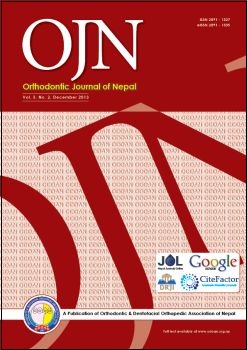Prevalence of White Spot Lesion in Nepalese Patients with Fixed Orthodontic Appliance
DOI:
https://doi.org/10.3126/ojn.v3i2.10070Keywords:
fixed orthodontic appliance, oral hygiene, plaque, white spot lesionAbstract
Introduction: Enamel decalcification in the form of white spot lesion is a common complication seen in patients with fixed orthodontic appliances.
Objective: To determine the prevalence of white spot lesion among Nepalese fixed orthodontic patients, to compare the occurrence of WSL among the patients with lesser and greater duration of treatment, and to compare between the gender groups.
Materials & Method: A cross-sectional study was done to compare the prevalence of WSL between 300 orthodontic patients and 100 non-orthodontic subjects. Further comparison was done between the mean treatment duration between orthodontic subjects of 6-18 months and >18 months, and between male and female samples. Subjects were visually examined on second premolar to second premolar in both maxillary and mandibular arches using Gorelick’s WSL index. Descriptive statistics were calculated and independent t-test was used to compare the difference between the groups. The p-value <0.05 was considered significant.
Result: The prevalence of WSL in Nepalese orthodontic patients was 54.3%; among them prevalence was 40% in lesser treatment duration group and 68.7% in greater treatment duration group. The study found significant difference between untreated nonorthodontic group and orthodontically treated group with respect to the number of teeth affected with WSL. Also, there was significant difference between the categories of orthodontic treatment duration. There was no significant difference between male and female samples.
Conclusion: Fixed orthodontic treatment increase the risk of white spot lesion. Duration of orthodontic treatment also showed significant increase in the occurrence of WSL.
Downloads
Downloads
Published
How to Cite
Issue
Section
License
Copyright © held by Orthodontic & Dentofacial Orthopedic Association of Nepal
- Copyright on any research article is transferred in full to the Orthodontic & Dentofacial Orthopedic Association of Nepal upon publication in the journal. The copyright transfer includes the right to reproduce and distribute the article in any form of reproduction (printing, electronic media or any other form).
- Articles in the Orthodontic Journal of Nepal are Open Access articles published under the Creative Commons CC BY License (https://creativecommons.org/licenses/by/4.0/)
- This license permits use, distribution and reproduction in any medium, provided the original work is properly cited.




